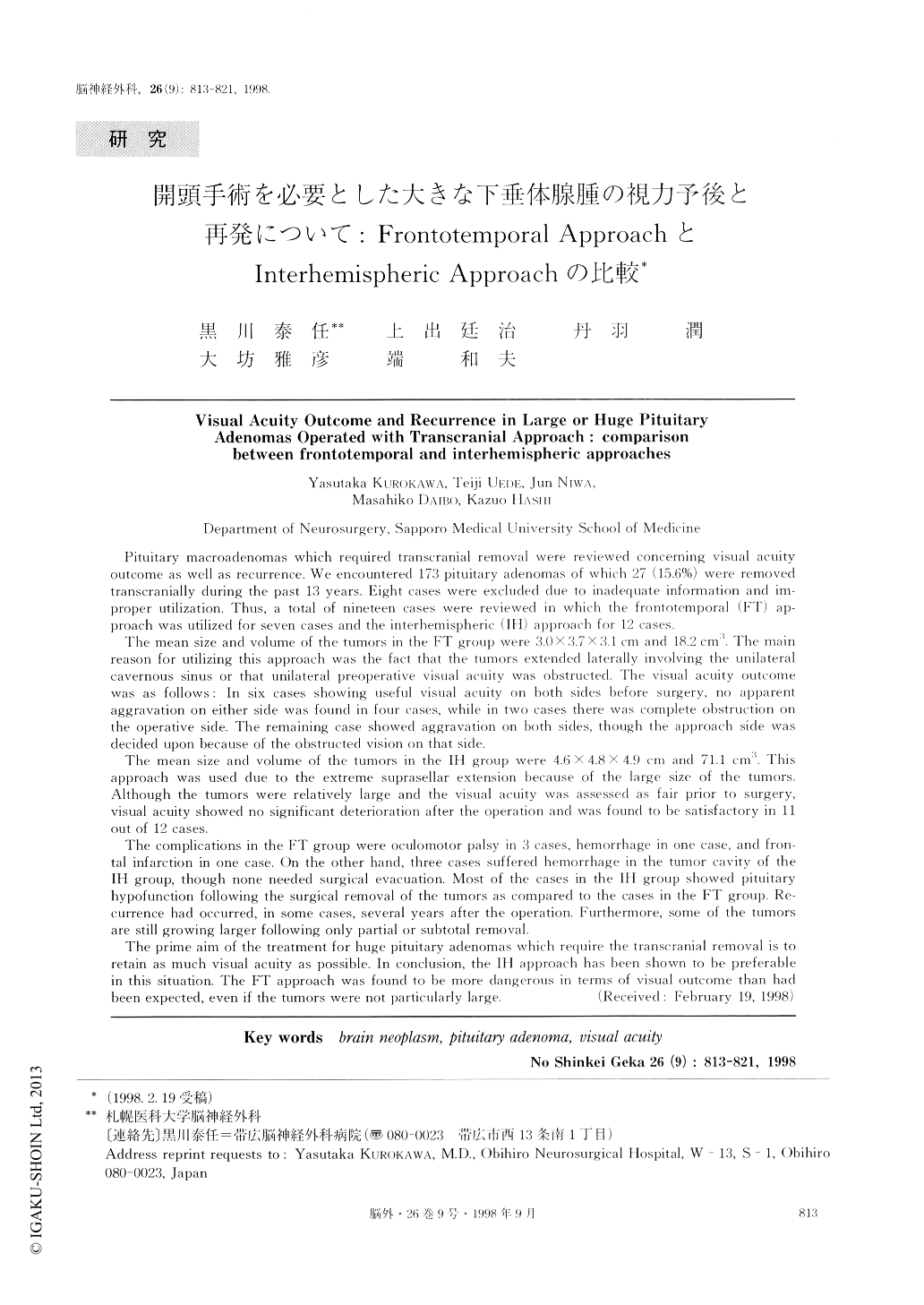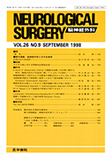Japanese
English
- 有料閲覧
- Abstract 文献概要
- 1ページ目 Look Inside
I.はじめに
下垂体腺腫の手術目的は,1)異常高値を示すホルモンの正常化,2)術後のホルモン分泌の機能低下を引き起こさない,3)腫瘍自体のmass effectの減少(主に視神経に対して)である.しかしながら,腫瘍が大きくなり,また再発を繰り返すような例ではその発育形式はinvasiveで,全摘出することはきわめて困難である.すなわち,機能性腺腫におけるホルモン値の正常化や,術後に下垂体機能低下を引き起こさないようにすることは,ほぼ不可能である.したがって,大きなもの,あるいは再発例における下垂体腺腫の手術の目的はただ1つ,視神経に対する減圧,すなわち視力の維持のみといっても過言ではない.
このような下垂体腺腫例において,開頭手術を必要とした大きな下垂体腺腫摘出の手術アプローチ法の違いによる予後,特に術前後の視力の変化と腫瘍の再発について検討した.
Pituitary macroadenomas which required transcranial removal were reviewed concerning visual acuityoutcome as well as recurrence. We encountered 173 pituitary adenomas of which 27 (15.6%) were removedtranscranially during the past 13 years. Eight cases were excluded due to inadequate information and im-proper utilization. Thus, a total of nineteen cases were reviewed in which the frontotemporal (FT) ap-proach was utilized for seven cases and the interhemispheric (III) approach for 12 cases.
The mean size and volume of the tumors in the FT group were 3.0×3.7×3.1 cm and 18.2cm3. The mainreason for utilizing this approach was the fact that the tumors extended laterally involving the unilateralcavernous sinus or that unilateral preoperative visual acuity was obstructed. The visual acuity outcomewas as follows: In six cases showing useful visual acuity on both sides before surgery, no apparentaggravation on either side was found in four cases, while in two cases there was complete obstruction onthe operative side. The remaining case showed aggravation on both sides, though the approach side wasdecided upon because of the obstructed vision on that side.
The mean size and volume of the tumors in the IH group were 4.6×4.8×4.9 cm and 71.1 cm3. Thisapproach was used due to the extreme suprasellar extension because of the large size of the tumors.Although the tumors were relatively large and the visual acuity was assessed as fair prior to surgery,visual acuity showed no significant deterioration after the operation and was found to be satisfactory in 11out of 12 cases.
The complications in the FT group were oculomotor palsy in 3 cases, hemorrhage in one case, and fron-tal infarction in one case. On the other hand, three cases suffered hemorrhage in the tumor cavity of theIH group, though none needed surgical evacuation. Most of the cases in the IH group showed pituitaryhypofunction following the surgical removal of the tumors as compared to the cases in the FT group. Re-currence had occurred, in some cases, several years after the operation. Furthermore, some of the tumorsare still growing larger following only partial or subtotal removal.
The prime aim of the treatment for huge pituitary adenomas which require the transcranial removal is toretain as much visual acuity as possible. In conclusion, the IH approach has been shown to be preferablein this situation. The FT approach was found to be more dangerous in terms of visual outcome than hadbeen expected, even if the tumors were not particularly large.

Copyright © 1998, Igaku-Shoin Ltd. All rights reserved.


